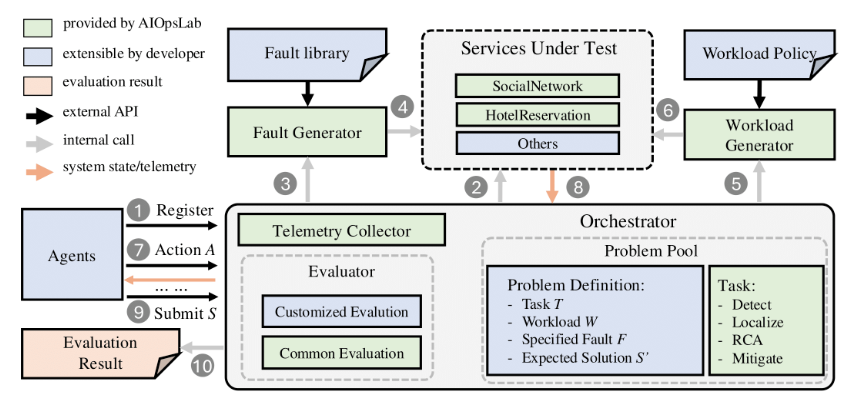Recently, Microsoft collaborated with research institutions such as the University of California, Berkeley, and the University of Illinois to open-source a project called AIOpsLab, aimed at providing an intelligent agent system for cloud automation operations. AIOpsLab can simulate complex operational tasks in real cloud service environments, supporting automatic detection, localization, and resolution of failures, significantly enhancing the observability and operational efficiency of cloud services.

The main feature of AIOpsLab is its modular design, which supports collaboration between humans and digital agents, making it easier for developers to extend applications, handle different workloads, and manage failure scenarios. Its architecture consists of five key components: the coordinator, services, workload generator, fault generator, and observability.
The coordinator is responsible for establishing sessions with agents and sharing information about benchmarking issues. It assists agents in effectively solving tasks by calling a series of documented APIs (such as retrieving logs and metrics). The coordinator can also perform operations on behalf of the agents, such as scaling or redeploying services, ensuring that agents can operate smoothly in real environments.
The services module can adapt to various real cloud service environments, such as microservices, serverless, and monolithic services. AIOpsLab also utilizes the open-source application suite DeathStarBench, providing researchers with a tool to reproduce and study production events in a controlled environment. Additionally, by integrating tools like Blueprint, AIOpsLab can extend to other academic and production services, facilitating the rapid deployment of new variants.
The workload generator plays a crucial role in AIOpsLab, responsible for creating simulations of normal and failure scenarios to test the performance of agents under different conditions. It generates corresponding workloads based on the specifications from the coordinator, helping users conduct tests across various situations.
The fault generator is an innovative feature of AIOpsLab, capable of implementing fine-grained fault injection in multiple cloud scenarios. This feature simulates the entire process of complex failures while considering the interdependencies between microservices, providing users with comprehensive testing and evaluation capabilities.
Finally, the observability function enhances AIOpsLab's comprehensive monitoring capabilities by integrating various monitoring tools, ensuring that users can obtain customized system information for effective management in the event of potential data overloads.
Open-source address: https://github.com/microsoft/AIOpsLab/?tab=readme-ov-file
Key Points:
🌐 Microsoft collaborates with universities to open-source AIOpsLab, aiming to enhance the automation capabilities of cloud services.
🛠️ AIOpsLab consists of five components: coordinator, services, workload generator, fault generator, and observability, supporting various cloud service environments.
🔍 The observability feature integrates multiple monitoring tools to ensure users receive effective system information and monitoring capabilities.

